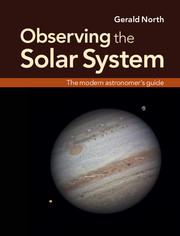Book contents
- Frontmatter
- Contents
- Preface
- Acknowledgements
- Chapter 1 Earth and sky
- Chapter 2 Moon and planet observer's hardware
- Chapter 3 The Solar System framed
- Chapter 4 Stacking up the Solar System
- Chapter 5 Our Moon
- Chapter 6 Mercury and Venus
- Chapter 7 Mars
- Chapter 8 Jupiter
- Chapter 9 Saturn, Uranus and Neptune
- Chapter 10 Small worlds
- Chapter 11 Comets
- Chapter 12 Our daytime star
- Appendix 1 Telescope collimation
- Appendix 2 Field-testing a telescope's optics
- Appendix 3 Polar alignment
- Index
Chapter 10 - Small worlds
Published online by Cambridge University Press: 05 November 2012
- Frontmatter
- Contents
- Preface
- Acknowledgements
- Chapter 1 Earth and sky
- Chapter 2 Moon and planet observer's hardware
- Chapter 3 The Solar System framed
- Chapter 4 Stacking up the Solar System
- Chapter 5 Our Moon
- Chapter 6 Mercury and Venus
- Chapter 7 Mars
- Chapter 8 Jupiter
- Chapter 9 Saturn, Uranus and Neptune
- Chapter 10 Small worlds
- Chapter 11 Comets
- Chapter 12 Our daytime star
- Appendix 1 Telescope collimation
- Appendix 2 Field-testing a telescope's optics
- Appendix 3 Polar alignment
- Index
Summary
On the evening of 1 January 1801 Guiseppi Piazzi was engaged in the observational work necessary for the compilation of a new star catalogue when he found an unfamiliar object in the constellation of Taurus. The object looked like a star of the eighth magnitude. When Piazzi observed on the following night he found that it had shifted against the pattern of fixed stars. Clearly this was not a star. It turned out to be a previously unknown member of the Solar System.
THE MAIN BELT ASTEROIDS
The mathematician Karl Gauss found that the new body, which Piazzi named Ceres, orbited the Sun at a distance of 27.7 AU (about 430 million km). It was obviously small. We now know that its diameter averages about 950 km (it is slightly oblate).
As discussed in Chapter 1, a group of astronomers known as the ‘Celestial Police’ had already begun searching for new members of the Solar System. They carried on searching. On 28 March 1802, Celestial Policeman Heinrich Olbers found a second small body, Pallas, which moves at roughly the same distance from the Sun but in a much more eccentric and highly inclined orbit than Ceres. Then in September 1804 another Celestial Policemen Karl Harding discovered a third, Juno, and in March 1807 Olbers found a fourth, Vesta. All these bodies turned out to be smaller than Ceres (of the order of half Ceres’s diameter).
- Type
- Chapter
- Information
- Observing the Solar SystemThe Modern Astronomer's Guide, pp. 313 - 356Publisher: Cambridge University PressPrint publication year: 2012



